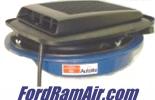> The blocks have an XE number If I recall.Yes. The block will have an XE casting number prefix (e.g. XE 192540).
The pan rail will be straight, not sculpted and the main caps will be 4
bolt. The caps are reputed to be thicker and made of higher nodular iron.
Supposedly, there are Siamese bore and non-Siamese bore versions.
> Dan Jones (who monitors this list) has one right now.
Yes indeed :-)
>They were made for racings and I have heard that only 300 or so were cast.
>Of these 300 a large portion of them have enough core shift to negate any
>"Thick wall" benefits.
I should find out in a month or so when I borrow the sonic tester. The block
looked good to the naked eye with uniform material distribution around the cam
bearings, etc. The block needs one sleeve but the seller only wanted $200 for
the block so I figured it was worth the risk. The sonic test and magnaflux
should tell all.
Be aware there are Aussie blocks and then there are Aussie blocks. From what
I've been able to gather, there were:
1. Blocks imported from the U.S. before Australian-sourced blocks were available.
Could be either 2 or 4 bolt mains.
2. "Blue blocks" (painted Ford blue). These were the earliest Australian 2 bolt
main castings. Probably not any thicker than comparable U.S. blocks.
3. "Black blocks". These were later Australian 2 bolt main castings that were
introduced along with electronic distributors. The distributor hole (at the
bottom) is smaller so U.S. and earlier Aussie distributors won't fit without
modification. The distributor hole is the same except for the hole in the block
that holds the very bottom of the distributor. The diameter difference is small.
Supposedly a thicker casting than the "blue blocks".
4. 4 bolt main non-Siamese bore. A special casting for U.S. racing. Only a few
hundred made. This is the one with the straight pan rails. The real NASCAR blocks
will have an XE casting number prefix (e.g. XE 192540), thick, non-contoured main
bearing webs, one inch thick block skirt (pan rail), heavier, high nodular iron
four bolt main caps, and 0.165 inch minimum thickness cylinder walls.
5. Same as number 4 but with Siamese bores. I'm not sure if there's any cooling
issue with using these on the street. Use a coat hangar snaked in through the
core plug holes to test. If it's Siamese, the cylinder walls will touch and you
won't be able to push it through the adjacent cylinders.
There could be others. I've heard of Aussie truck blocks but I don't know if they
are any different than passenger car blocks. After the U.S. 351C supply dried up,
DeTomaso sourced the engines from Australia. They were basically truck motors
with open chamber 2V heads. I've heard nothing special claimed about the blocks.
Also, Aussie 302C and 351C blocks interchange.
Kip at the Pantera Performance Center has sonic tested a bunch of the Mike Fielder
sourced Aussie 2 bolt main blocks and found them to be nothing special. I had one
of those blocks and bare, clean, with main caps and a standard bore, it weighed in
at 172 lbs on a digital bathroom scale. IIRC, the XE block weighed in at 190 lbs.
Kip has had several XE 4 bolt main blocks in the shop and said they were all great
(no core shift problems) and he's bored them out as much as 0.187" over (to fit a
sleeve) and never gone through a wall. My Aussie 2 bolt block had no Cleveland
Foundry marks but had a D2AE-CA casting number, the same as one of my 4 bolt main
U.S. blocks. Paul Timko has some jpegs of his 2-bolt Aussie block from that show
bulges between the freeze plugs and the pain rails. His block has casting number
is also D2AE-CA. Both of my Aussie blocks have lots of X's and Y's in the lifter
valley but others have noted U.S. blocks with the same markings. Cary Foster
pointed out there is an oval Ford logo to the left of the oil pressure sender on
an Aussie block that he has from a 1984 Longchamp GTS. U.S. blocks may have a
smaller (1") poorly defined oval there but the Aussie block oval is larger (1.5"
to 2") and very well defined.
I can't get pictures of the XE block at the moment as I'm 400 miles away from it
but I'll try to get some pictures taken in a month or so. I guess I should also
shoot some pictures of the 400 block with small block bellhousing. Hmmm, maybe
it's time to buy a digital camera.
Dan Jones











 Mustangsandmore Forums
Mustangsandmore Forums

 Ford Racing
Ford Racing

 Australian blocks
Australian blocks


